Clouds live outside.
Clouds don't belong in indoor pictures. This was taken on stage just before read more

sets, photos
 10
PHOTOS
10
PHOTOS
 10
PHOTOS
10
PHOTOS
 10
PHOTOS
10
PHOTOS
 10
PHOTOS
10
PHOTOS
 10
PHOTOS
10
PHOTOS
 10
PHOTOS
10
PHOTOS
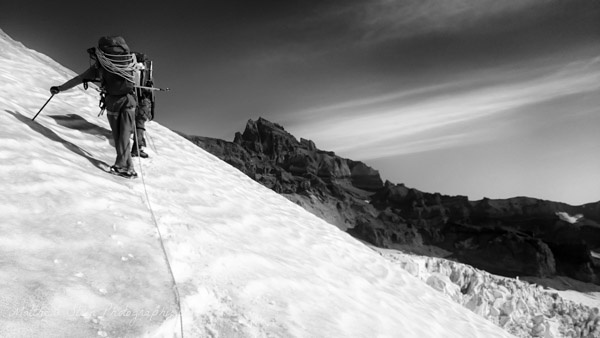
Matthew Stein, Posted Aug 26, 2015 8:57:00 PM
The bunkhouse door flew open. Time to wake up and start our ascent. By 12:40am, we rigged for glacier travel and started hiking. We stepped outside into the howling wind, sandblasting our faces with volcanic dust. Our down parkas kept us warm in the coldest temps we'd faced so far. We were finally ready to head up the rock and ice to the summit.
Before the day of our summit push, we spent 5 days learning what we needed to know to survive.
Our group met at Base Camp for RMI. 9 climbers and 3 guides. Our guides, Ben and Katrina, taught the group today. Caleb would join us for the climb the next day. The other climbers were Chris, Jan, Vlad, Peter, Scott, Edgar, Philippe and Harrison. We all signed up for the Paradise Expedition Skills Seminar
This day was a classroom day. We started with a thorough gear check. The guides suggested some things we leave behind and some things we needed to rent. My gloves and snowboarding jacket were not good enough. I rented some "Oh-shit mitts" and a belay parka. Definitely a good call.
We covered knots and putting on on crampons. Then we tried a little ice climbing and crevasse self-rescue. That's basically ascending a fixed line with a couple of cordolettes. After the lessons, we ate at the Bar and Grille on-site.
I had made a reservation for that night in a nearby town. However, Scott was kind enough to give me his reservation so I could stay in the bunkhouse and not have to make the extra trips. A nice single room with a queen sized bed. That would be the last good night's sleep I'd get for a week.
We assembled at Base Camp, and piled into the van. They drove us to the Visitors Center at 5420 feet. We distributed group gear, did final pack checks, and hit the trail. It was a steady hard hike with quite heavy packs. I'd guess around 60 lbs.
My waist belt wouldn't stay tight enough, it kept slipping down and rubbing my hips. High steps were difficult and painful since it would cut into my hip flexors. I didn't have to stop, but I knew a bruise was forming.
An hour in we made our first stop. We were still below the tree line and started to see scrubby plants and fewer tall trees. The next hour brought us up to the skree section. Sand and small rocks remained after the glacier movement ground them to dust. It's difficult to climb, since you will sink or slide 6 inches for a 1-foot step.
At the second stop a few people started taping up hotspots. It was hot, mid 70s, and we were all sweating. My trail mix completely melted together. I could no longer pick out individual pieces. Everything was bound together by melted chocolate and yogurt covering from the pretzels.
Our third stop brought us up to the base of the glacier. We roped up with crampons, gaiters, harnesses, lightweight gloves, and helmets. The sunlight reflecting from the ice would quickly burn any exposed skin. Most of us added another layer of sunscreen. Once on the glacier, the temperature dropped another 10 degrees or so.
Caleb, one of our intrepid guides, taught us how to walk in crampons. He covered the duck step, crossover step, and a little bit of front pointing. Then we started up Paradise glacier. The usual spot for low camp had too thin cover, so we hiked up another 45 mins for another 150 feet in elevation gain.
At 7480 feet, we ditched our packs and grabbing shovels. Time to prepare our campsite. That was some serious work. We rotated 3 shovels through the group to break up old snow and ice. The others kicked and stomped the loosened stuff to level it.
After making camp, we hung out for a few hours, then heated water for dinner. As the sun set, we shared stories, learned about pressure breathing, and heard tales of climbing Aconcagua in Argentina. The food on that trip is incredible, as is the wine of course. Maybe in 2017 I can put that on my list.
By 9pm we piled into our tents and started thinking about tomorrow. I could hear Katrina's laughter travel over the glacier from the guides tent. We'll never know if they're just telling stories or joking about our fun group. I suspect a little of both.
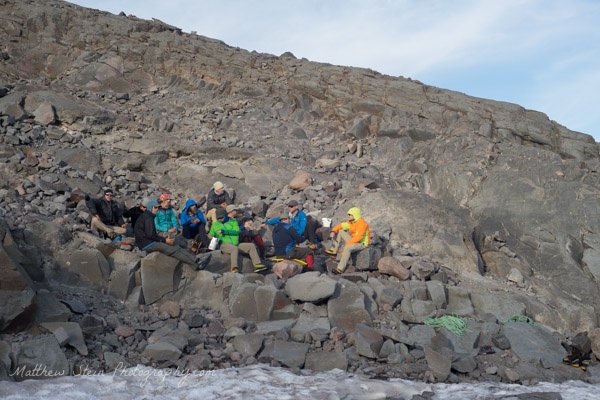
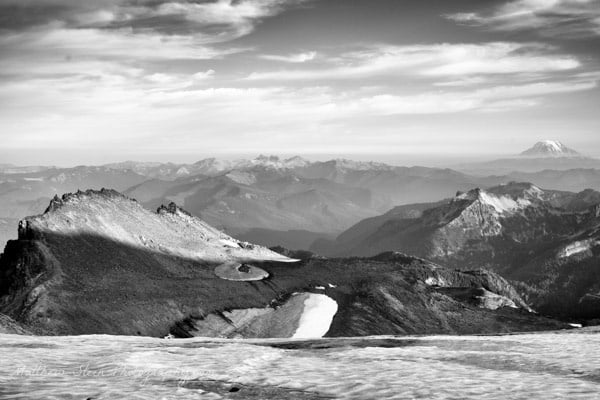
I woke up shivering. A few deep breaths helped to stop the shivering, but they didn't make me want to get out of my sleeping bag any sooner. Eventually I heard the call for hot drinks, and dragged myself out of the tent.
Sleeping was problematic since I was cold. Nonetheless, we had plenty of time so I did get some decent rest.
After breakfast on the warm rocks, (oatmeal and coffee,) Katrina taught a self-arrest class. Unlike on the East coast, here we used our crampons to help catch falls. Making a tripod with our asses in the air, we dug in our feet and leveraged the ice axe pick into the ground braced against our upper body.
We broke camp, and headed up the glacier.
I was second on Ben's rope. That gave me a great vantage point to watch him route finding. The pace was steady. But with my heavy pack I was approaching my pace limit. We worked our way up to a big crevasse. Ben walked up and down to find the best place to cross. He placed a picked and cut some steps down the crevasse onto an ice plug. It was stable enough for our team to cross. Each of the rope teams were belayed down the steps into the crevasse and across the ice plug. Climbing up the other side we had a little adventure in ice climbing and front pointing. That was exactly what I hoped to get from this trip.
We continued up into a safe place for our next break. One final push from there and we made camp. After digging in our tent platforms again, we took a short break. I read in my tent.
Anchor building class time with Ben. We started with a single picket, or nail, then a midpoint buried anchor. Next we flipped the pickets horizontal and learned about burying a deadman's anchor. The group split in two, and practiced building a bollard rope anchor. Each of these have different uses and applications.
We covered equalizing anchors with multiple points. I learned this process with SERENES as the acronym for rock anchors. RMI teaches ERNESTA instead. Equalized, redundant, no extension, solid, timely, and angle. Ben used my favorite demo to show the multiplication of forces depending on angle of pull. Have two people stand shoulder to shoulder, holding ends of a rope. Then have one person pull on the loop. The rope-holders probably won't budge. Each supports 50% of the weight. Next, move the people so the rope forms a 90 degree angle. Now they're fighting 100% of the weight. The single person can probably move them. Lastly, they stand completely apart, and the person pulls on the middle of the rope. Each of the anchor people are now receiving 200% of the force, and it's really easy to pull them off their feet.
Katrina and Caleb had been sent ahead to scout our route, to make sure we could get to Camp Muir in the next few days. They returned just in time for dinner. They really hauled ass up and back down the glacier. We could see them running down the sloped as they approached camp again.
While we waited for our dinners to hydrate, Ben covered Glaciology. How they form, how crevasses are made, and the basics of how to read them and route-find a way across. He rehashed his story from earlier today when his leg punched into a crevasse. Fortunately, it was very easy for him to get back out on his own.
Vlad, the cook from Detroit, and I realized that we were both heading back to Seattle shortly after our return. He offered me a ride in his rental car. We were going to have the chance to hang for a little while after this trip.
Philippe and I climbed over the rocks above where we cooked dinner, and admired the tiny flowers growing there. These micro flora are quire impressive, considering the rest of the rocks look like a lunar landscape.
The sunset lit up the haze in many colors, The smoke from the forest fires took a toll on visibility. Mount Adams was mostly obscured, Mount Hood and even Mount Saint Helens were completely gone.
That night I wrapped the feet of my sleeping bag with my belay parka. I borrowed Edgar's parka for an extra blanket for my top. That helped me stay a little warmer.
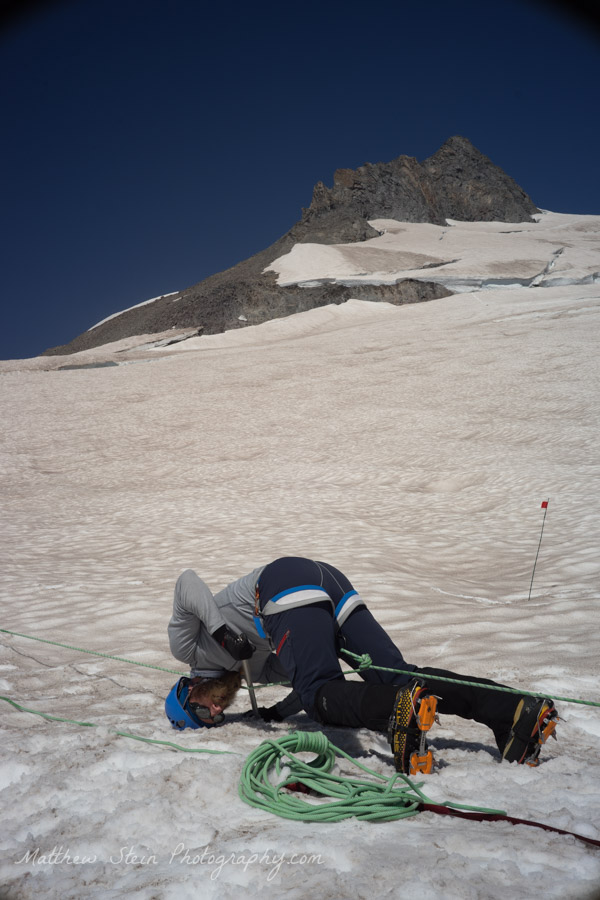
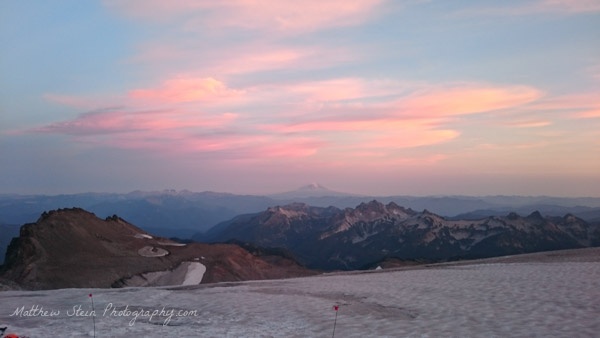
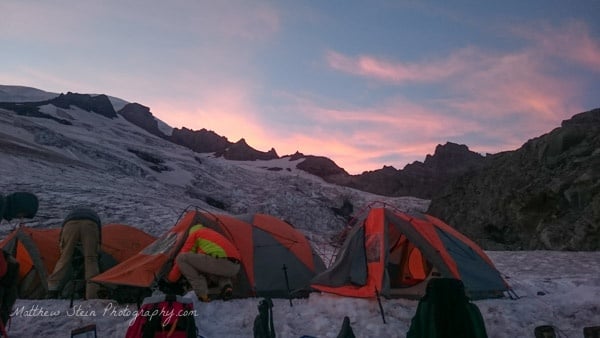
I woke before dawn with my alarm. Originally, I planned on shooting a time lapse of the sunrise. Instead I shut it off and went back to sleep. Bad photographer.
When the guides came around to wake us up, I finally rose and got dressed. Breakfast was a double oatmeal packet and coffee. Starbucks VIA is pretty awesome for camping.
We kitted up for glacier travel, but with light packs. We made our way to a nearby crevasse about 20 minutes walk away. Ben, Katrina and Caleb set up 2 main anchors, and a backup safety belay. We broke up into teams and practiced 3 man crevasse rescue.
One rope-team member jumps into the crevasse. The middle man catches them and arrests the fall. The lead team member executes the rescue. The process started with backing up the arrester, transfer their load onto an anchor, rap down to the victim and make sure they are OK, then set up a 3:1 haul system to pull them out. We rotated through so everyone could play each role.
Katrina and Caleb demo'd a single person rescue. She roped up and went over the lip. He pulled her topside in just under 7 minutes. While narrating and demoing some new gear.
Finally, we learned a brute force rescue. I was voluntold to jump in the crevasse (on a rope of course.) Seven people topside threw a friction hitch on to the rope and pulled. I literally came flying out of the crevasse there was so much power with everyone pulling.
We roped back up and returned to camp for lunch.
Following a little break, we practiced ascending fixed lines, (on an easy slope) and descending a fixed rope with an arm-friction grip. The rest of the day was spent hanging out in tents or shooting the shit until dinner time.
That night, I layed out my goretex pants and jacket under my sleeping pad for an extra layer of insulation from the ice we were sleeping on. It helped a bit more.
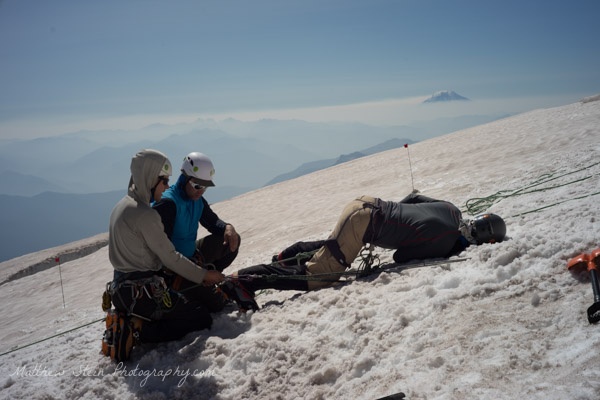
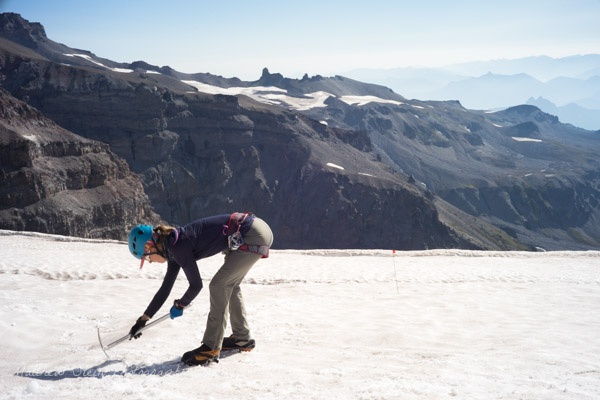

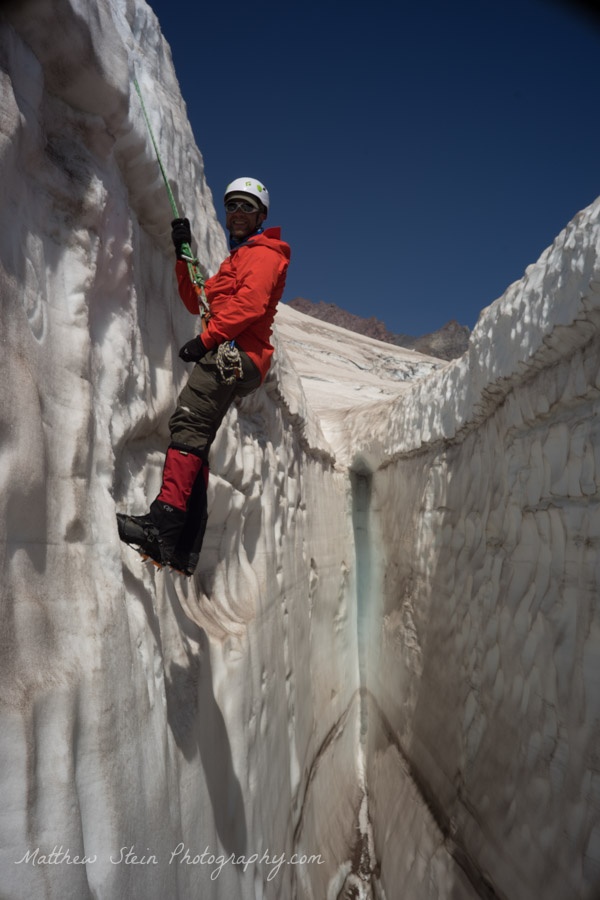
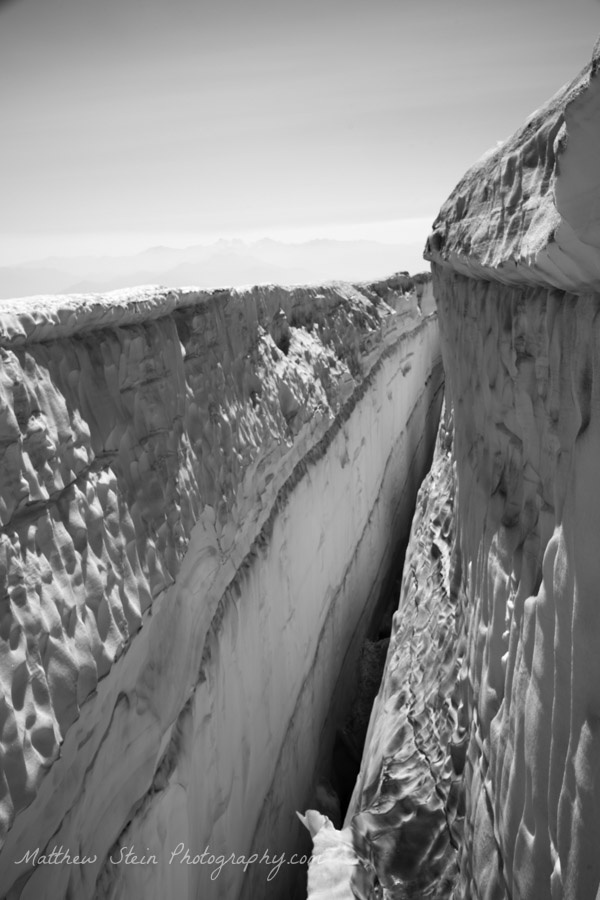
One day before the summit, an easy day. Well, as easy as it gets at altitude. We breakfasted, packed up camp and hiked up to Camp Muir at 10,000 feet.
RMI has their own bunkhouse at Muir. That's a really nice resource. 18 Bunks. Each bunk has it's own pile of 3 foam pads.
We moved in, exploding our packs. Sharps remained outside, bedding food and clothes came inside. Crampons, ice axes, trekking poles and packs needed to be outside on the ledge staged for the ascent.
Katrina gave the summit talk. What would we be wearing. What to expect. Where is the route we’re taking up. Who’s on which rope team. Eat, drink, pack light, get ready for a long haul. The forecast called for 70 MPH winds and temps in the 20's. The freezing level was well below 10,000 feet.
By 6pm we were horizontal, and trying to sleep. Of course, it was still light out, and the wind howled around us. The door wouldn't latch. Instead, it creaked and cracked in little gusts, and banged around in stronger winds. Sleeping well wasn’t going to happen.
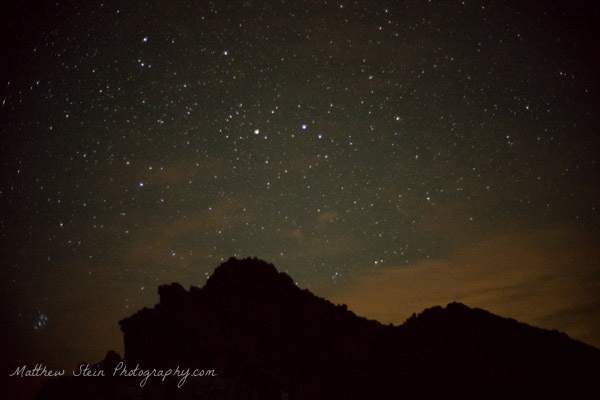
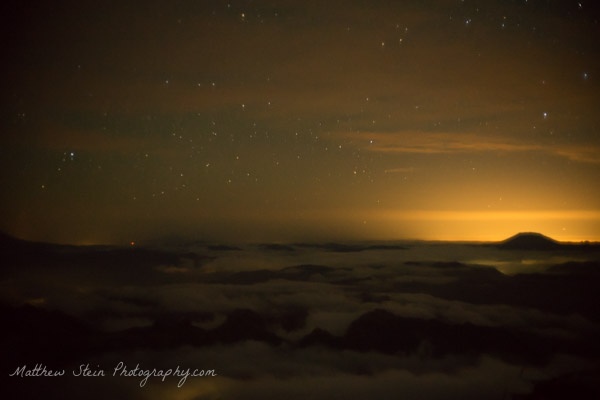
At 11:35 pm, the bunkhouse door flew open. Time to wake up and start our ascent. We had one hour to eat breakfast, gear up and plunge into the windy darkness.
Groggily everyone started shuffling around, putting on boots, gaiters and crampons. Helmets already outfitted with headlamps shone around the bunkhouse. I finished my oatmeal, but leave most of my coffee and head outside. The wind blasted everyone in the face with sand and grit. I'm glad I wore my ski goggles.
Stars filled the night sky. I braced my camera on a gear table for a night time shot of Mount Saint Helens and pick up the light pollution from Portland.
I left camp on Ben's rope team, with Edgar and Vlad. We made our way slowly up to the Inghram flats. Across those, we hustled under the Ingram Ice Falls and rock-fall zone known as the bowling alley. After crossing the glacier, we arrived at the base of the Disappointment Cleaver.
Moving up the Disappointment Cleaver was very hard work. We alternated between a cross-wind and a head wind while walking up hill. Ben set a steady, slow pace and we followed closely by. The loose dust, sand and scree slid down with every step up we took. A 12 inch step resulted in a 6 inch back slide. I found it very difficult to get into a rhythm and establish my rest step. Pressure breathing helped keep my heart rate down and head clear. The altitude made me noticeably slower, but not nauseous or light-headed.
Four and a half hours after we left camp, we arrived at the top of the cleaver at 12,000 feet. It's now around 5am. We waited here for the rope teams to regroup. Ben asked us very directly if we were 100% going to the top. Now was the time to turn around if we didn't think we could make it.
Caleb and Katrina's rope teams arrived. Scott, one of the climbers, was severely hypoxic. He was obviously going back down. Caleb and Katrina watched him closely, keeping him awake and hopefully not throwing up on himself or other people. Katrina tried to get him to eat a few different things, GU, M&Ms, snickers, but nothing stayed down. He couldn't even drink water. Altitude does strange things to you.
At this point, I realized that I wasn't recovering as well during this break. I forced myself to eat a pack of M&Ms. I really didn't want to eat anything. Continuing to take pressure breaths, my legs weren't feeling better. On top of that, the winds were getting worse. Even if we continued up past the cleaver, we didn't know if the conditions would allow for a full summit. We ascended 2,000 feet so far, but still had another 2,400 to the summit.
I decided to turn around, eliminating my chance to summit that day. If I hadn't been fighting a 45 mph headwind up the last 2000 feet, it would have been a different story. The prospect of dealing with 70 mph winds at the summit was not appealing either.
Two of our rope teams descended back to Camp Muir. Ben led the three brave souls towards the summit.
Katrina asked me to lead our rope team, seconded by Edgar. Scott was in third, so Katrina could keep a close eye on him in fourth. It's much easier to be "Heads-up" climbing when you're at the front of a rope team. The rest of the time, you're following the lead's footsteps very closely. At the front, you can look around, and do some route-finding. You can figure out what is the best way to head down, look for trail markers and decide when to start switching back or turning.
Now the sun was starting to warm up the sky. A deep orange glow spread across the horizon, under a thin layer of clouds. We continued down the cleaver a few hundred more feet.
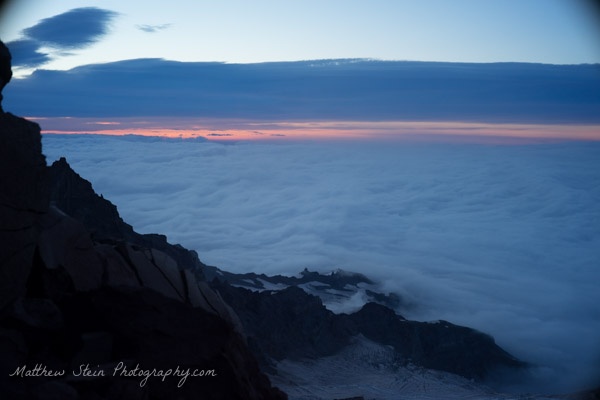
Once we reached the bottom of the cleaver, Katrina reversed our rope order and moved herself to the front of the team again. We lengthened our rope intervals for glacier travel. First we needed to cross the rock falls, and Inghram ice falls. Scott was still affected by altitude sickness, and tried to kneel for a quick break in the rock fall zone. Katrina was all over him to get him moving through the danger section. "Scott, there's a reason this section is called the Bowling Alley!"
Past the danger zone, we took a break on the Inghram flats. The sky brightened and we no longer needed headlamps. The sun broached the horizon, and we saw the glacier get gradually illuminated. Another 2 hours down and we were back at Muir.
Most of us went back to bed, and grabbed a few more hours of sleep. The summit teams were originally expected to return around 12:15. The weather set them back over an hour and a half. They returned triumphantly just before 2pm. Jan, Peter and Kris all summitted successfully with Ben.
After they recovered and re-packed, we started down the Muir Snowfield. We boot-skiied down the snow and tried to avoid landing on our asses. Descending into the clouds, we took our final break at Pebble Creek. Glacier melt cascaded down the nearby rocks. The mist and scrubby bushes reminded me of Scotland.
We only had a few more miles to go. The trail evolved from dirt, to gravel and eventually to asphalt. During the whole trip I had zero problems with my feet. My boots were just fine. But, once we got onto the asphalt, I started getting hotspots on my big toes.
Finally we arrived in the parking lot, met the van and loaded up our gear. Shortly thereafter we were enjoying pizza, beers, and formulating plans to try for the summit again in the future.
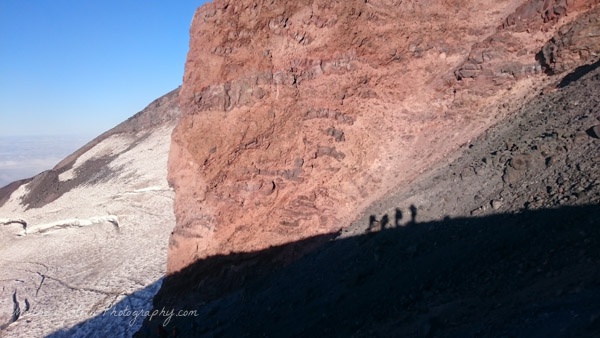
Clouds don't belong in indoor pictures. This was taken on stage just before read more
Love it or hate it, Pokemon Go is everywhere. If you hate it, then you're probably not reading this. You also don't care how to take better pictures within ... read more
Inspired by The Rye Baker by read more
Comments